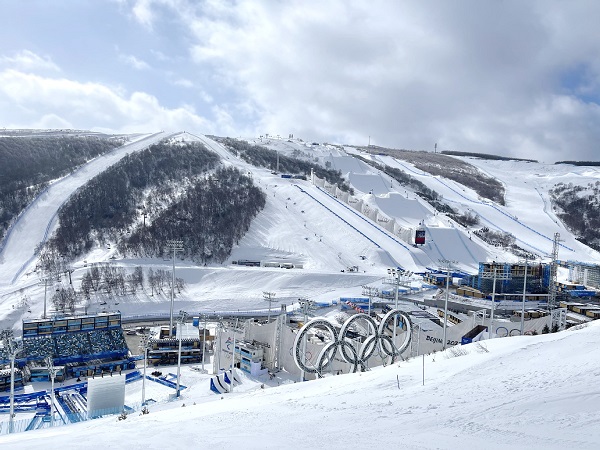Winter Olympics will leave a lasting legacy for hosts

The National Cross-Country Skiing Center located in Chongli distrct in Zhangjiakou, North China's Hebei province, Feb 9, 2022. [Photo/IC]
As the first city to host both Summer and Winter Olympic Games, Beijing reused many of its iconic sporting venues from the 2008 Summer Games and will leave other positive legacies, including an improved economy, culture and environment, experts said.
"Not only will the venues of Beijing's Winter Olympic Games continue to serve the public as sports stadiums and city landmarks as a vital part of the legacy, but also the co-hosting of the Games by Beijing and Zhangjiakou, Hebei province, will drive the economic development in the region," said Jiang Yiyi, deputy head of the School of Leisure Sports and Tourism at Beijing Sport University. Jiang is also a researcher at the Beijing Winter Olympics Culture and Ice & Snow Sports Development Research Base.
The Big Air Shougang facility built in Beijing for freestyle skiing big air and snowboard big air will become a location for professional and international sports and cultural events.
Jiang said the Olympic legacy has been widened and deepened in recent years, which has added more dimensions in addition to physical venues.
Many of the outdoor winter events took place in Beijing's suburban Yanqing district and Zhangjiakou. Together with the competition zones in downtown Beijing, they formed a rough line northwest from Beijing through Yanqing to Zhangjiakou, about 180 kilometers from Beijing's city center.
The Chongli district in Zhangjiakou has been transformed from an impoverished and previously little known agricultural county into a hot tourism destination with a booming winter sports industry since Zhangjiakou became one of the competition zones for the 2022 Beijing Winter Olympics.
The Ministry of Culture and Tourism and related authorities have issued a plan to build a belt region that integrates the sports, cultural and tourist industries along the line, aiming at making the region a world-class example in post-Olympics reuse of Games venues and an international destination for winter sports, recreation and tourism.
According to the plan, a series of global winter sports events and competitions will be held, top-tier sports universities will be built and the charm of Chinese culture will be presented to the world through a host of cultural resorts, parks and brands in the region.
"China is going to drive the regional economic growth of the area through holding the Winter Olympics jointly in three zones," Jiang said. "For a long time in the past, Yanqing and Zhangjiakou, as ecological conservation areas, have contributed a lot to Beijing's ecological environment protection.
"They will seize this opportunity to develop the economy. Due to the infrastructure construction, the two areas have joined in a one-hour circle of transport with Beijing, which will greatly help economic growth."
Chongli has become home to the largest gathering of high-end ski resorts in China, with several in the top 10 nationally. The area has also hosted ice and snow events and training centers for the industry.
"The investment in the area will continue to help its rapid development," Jiang said.
The Winter Olympics have also left Beijing and Hebei with a coordinated mechanism in natural environmental protection, she added.
"People can obviously feel the air quality improvement in the region, since the local governments have been taking measures jointly in recent years," Jiang said.
As part of the Green Olympics initiative, the authorities emphasized ecological preservation, conserving resources and environmental friendliness. In line with the initiative, Games venues have applied more green technologies to reduce energy consumption as well as their impact on the environment.
A reservoir with a capacity of 200,000 cubic meters was built to collect water for the venues in Chongli, including the National Ski Jumping Center and the nearby National Cross-Country Skiing Center.
Li Zhenlong, venue and infrastructure manager of the skiing center, said the venue has five smaller water storage facilities eliminating the need to use underground water and harm the environment during snow-making.
"Also, we have planted many trees while constructing the courses," Li said. "Furthermore, the venue is 100 percent powered by wind and solar power. We have made great efforts to achieve sustainable development."
- Top legislature schedules session for December
- China's top legislator holds talks with president of Luxembourg parliament
- China's top legislator meets with French president
- China, Maldives pledge to enhance exchanges between legislative bodies
- Senior Chinese legislator meets Portugal's PSD delegation



